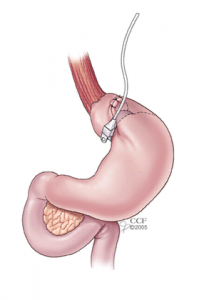Adjustable Gastric Banding

About the procedure:
In this procedure, an inflatable silicone band is placed around the top of the stomach to help control the flow of food through the stomach and decrease hunger. Based upon the needs of the patient, the balloon can be adjusted to decrease the small pouch outlet which slows the emptying of food into the larger portion of the stomach and then the intestines. As a result, patients experience an earlier sensation of fullness and are satisfied with smaller amounts of food. Reduced hunger, and decreased food cravings assist in maintenance of a diet resulting in weight loss. Vitamin, nutrient and medicine absorption are unchanged yet some medicines are not well tolerated after the procedure.
How It Works:
A small gastric pouch is created restricting meal volume, but more importantly, the band allows early and prolonged satiety. Patients feel satisfied with a small amount of food, and they are not hungry or looking for food between meals.
Indications:
The AGB is indicated for use in weight reduction for severely obese patients with a Body Mass Index (BMI) of at least 40 or a BMI of at least 30 – 39 with one or more severe co-morbid conditions, or those who are 30 lbs. or more over their estimated ideal weight. A patient with a BMI of 40 usually weights about 100 lb above their ideal body weight.
Malabsorption:
No change in vitamin or nutrient absorption is caused by the Adjustable Gastric Band
Vitamin Requirement:
Two daily multivitamins should be taken while a person is losing weight due to the decreased nutrient intake of dieting. Vitamin D as needed.
Dietary Restrictions:
Patients may experience difficulty with thick breads and fibrous foods. Patients must take care to thoroughly chew food after surgery to prevent regurgitation. A low carbohydrate diet enhances the effectiveness of this procedure.
Laparoscopic:
Yes
Number of incisions:
1 to 5 small incisions. Single incision surgery available to appropriate patients.
Intestinal Rerouting:
No
Cutting or stapling:
No
Hospital Stay:
Outpatient – patients typically go home the same day
Recovery:
Most patients return to normal activity in five days.
Full surgical recovery occurs in two to three weeks.
Post Op Diet:
As with all surgical weight-loss programs, it is imperative that band patients adhere to a strict postoperative diet. Patients must stick to a liquid protein diet for 2 weeks after surgery; they then graduate to 2 weeks of a soft protein based diet. And at 4 weeks, patients transition to a low carb solid diet. Once goal weight is achieved, usually 2-3 years after surgery, most patients consume a normal healthy diet with the appropriate number of calories for their height and build to maintain their weight.
Mortality:
The reported risk of mortality during the first 30 days following surgery for the adjustable gastric band is one in 2000 for a Center of Excellence Surgeon. Those who die rarely do so from the procedure, but usually from an underlying obesity related illness, such as coronary artery disease with subsequent heart attack. We have never had a peri-operative death following gastric band placement.
Hair Loss:
Patients may experience hairloss during the period of rapid weight loss, but hair growth usually normalizes with weight maintenance.
Bone Disease or Osteoporosis:
No increase in risk
Iron Defiency Anemia:
No increase in risk
Reversible?:
Yes. While it is intended to be a long-term treatment, the Adjustable gastric band can be removed at any time. The stomach is generally restored to its original form and function.
Easily Adjustable:
Yes. Adjustments performed without additional surgery. Allows individualized degree of restriction for ideal, long-term weight loss
Pregnancy:
Supports pregnancy by allowing stomach outlet size to be opened for increased nutritional needs
Contraindications:
The AGB is not recommended for non-adult patients (will be evaluated on a case-by-case basis), patients with conditions that may make them poor surgical candidates or increase the risk of poor results, who are unwilling or unable to comply with the required dietary restrictions, or who currently are or may be pregnant. Patients with Lupus are excluded from possible band candidates.
Weight Loss:
Typical patients lose weight at a rate of 1-2 pounds per week. While weight loss is usually slower with an adjustable gastric band than with RNY gastric bypass or Sleeve Gastrectomy, the weight loss period normally extends two to three years from the date of surgery.
Patients can expect to maintain a total excess weight loss of 55%.
